Mana is usually the first thing I look for when I examine a new set or a new format. Many players try to figure out what cards they want to cast and then seek the mana to cast them, but I find it better to figure out first what mana is available. In the case of Rise of the Eldrazi, there are some interesting new options, but notoriously missing are new reliable forms of colored mana at reasonable prices. Evolving Wilds is fine for block players, but Standard players already had access to Terramorphic Expanse, and more than four copies are not an exciting option.
There are four new colored mana sources are Prophetic Prism, Realms Uncharted, Growth Spasm and Mul Daya Channelers.
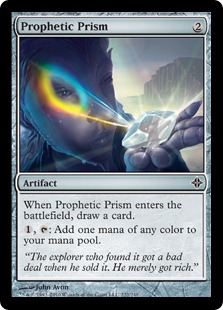
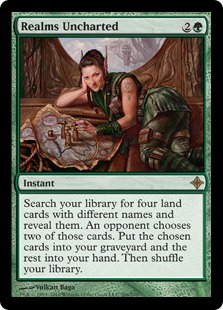
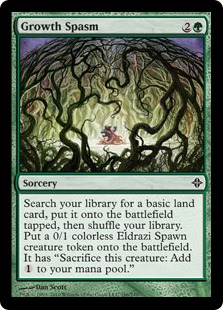
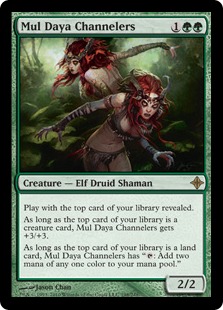
Prophetic Prism is not reasonably priced, as it requires a full two mana investment and fails to accelerate your mana. The game has accelerated past the point where one can afford that without getting concrete returns on the board and there are no interesting rewards to having artifacts in play.
Mul Daya Channelers and Growth Spasm share the problem that they cost three mana. Three mana is too much to pay for mana acceleration unless you are trying to accelerate to at least six mana, and unless you are bound for abomination land, aiming this high is a bad idea. Mythic is a great illustration of how even a deck where three quarters of the cards provide mana ends its curve with a handful of six mana spells. Mul Daya Channelers are not reliable providers of mana, and they are not reliable sources of savage beatings no matter how many creatures a deck plays. Even with some control over the top of your library, the mana can’t be counted on when you need it, and later on the Channelers will too often be small. Knight of the Reliquary is how to do this right, as it can serve both roles reliably.
Growth Spasm comes closer but still requires an entire turn of investment, and is highly awkward to cast any time other than turn 2 off a Birds of Paradise or Noble Hierarch. Rampant Growth is a better card as it can save you from early mana problems, where Growth Spurt creates them, and Growth Spurt is unable to uniquely accelerate into anything less than a six-drop. Harrow helps indicate how high the bar is for three mana spells that accelerate mana, only making the grade in decks that need the side effects. Either they want the landfall or they want to get rid of a Forest to get Mountains into play as fast as possible; old versions wanted to get the entire domain. In exactly the right deck this could work, but I doubt that deck is where you want to be.
Realms Uncharted is a card I’ve seen some people get excited about without reference to Life From The Loam, and I cannot understand why. In decks that run Life From The Loam, and whose primary purpose in life is to play about forty-three lands, this could prove quite interesting, but that’s how special case I expect this card to be. Realms Uncharted is a great example of a card that does exactly what you don’t want. Instead of accelerating you into more land drops, Realms Uncharted floods your hand with lands you cannot play. If there is a particular land you need, this won’t give it to you without more work, and if you do that work that’s even more lands stuck in your hand. One combination mentioned is Grim Discovery, but here is what we are talking about there: Realms Uncharted, then cast Grim Discovery, and you’ve traded two cards to get back a creature you don’t naturally have in the graveyard and put three lands into your hand.
Most of the time you’ll have at least one more there anyway early in the game, so all you’re doing is making sure you don’t miss land drops four, five and six and to do that you’re spending five mana and getting no acceleration in return. Yes you have extra cards but they’re all lands and they’re all slow. You’ve also probably ended up playing some suboptimal lands in order to make sure you can use Realms Uncharted effectively. To top it all off, it has the three mana problem: When you need those lands the most, you can’t have them. Another good card to contrast with is Expedition Map. The Map is expensive, but still gets played in the admittedly tier 2 Valakut decks because it gets you what you want with mana you can afford to spend and gets you the critical third mana.
The temptation is that people are comparing this to Gifts Ungiven, and seeing it as one mana cheaper. Gifts Ungiven let you choose the type of card you needed, whether it was lands, removal, threats or a combination that retrieved itself out of the graveyard. There were some devastating packages. There are no devastating land packages, there are only good lands. Don’t fall for this type mismatch. Cards that get you lands or mana operate under different rules than cards that tutor for spells.
Instead, a humble Elf is by far the best new mana source in the set for those not looking to unleash abominations on the world: Joraga Treespeaker. Joraga Treespeaker costs three mana and yields two per turn. Treespeaker gets to level 1 ‘for free’ since it immediately returns the two mana that was invested and then on future turns the extra two mana is available. Later in the game, it can be cast as a three-mana spell. The contrast with Mul Daya Channelers is stark, as this is a reliable source of mana that requires minimal investment. The risk is low and the potential payoff is high, including rescuing draws that don’t contain a third land.
That is the good news, but the bad news is going to mostly keep it out of Standard, at least for a while. The problems are color issues and stiff competition. Treespeaker only provides Green mana, which means that three of the first four mana sources you have are going to be Green. Treespeaker also very much wants to be played and leveled in the first two turns, and severely punishes lands that enter the battlefield tapped. Together these greatly incentivize decks running Treespeaker to be primarily Green in contrast to the Mythic mana creatures, all of which provide mana of at least three colors. The competition for Green mana creatures is high enough that Llanowar Elves is coming up short, and I can’t see Treespeaker beating out Noble Hierarch in anything but a dedicated Elf deck. Birds of Paradise is more vulnerable, but that limits this card to a few copies on the margins.
Rise of the Eldrazi takes the colorless route to fixing your mana. Rather than providing the easy mana fixing of Alara or Zendikar each color is encouraged to make its own way in the world or at most to take a minor companion. When they do so, they are rewarded with colorless spells and various sources of colorless mana that multicolor decks cannot afford. Players can get permanent mana or they can settle for Eldrazi Spawn which are the side effect or primary effect of a number of new spells:
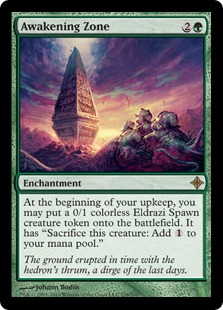
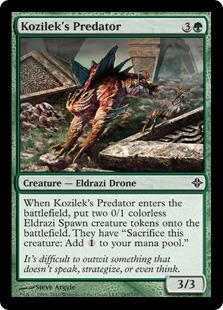
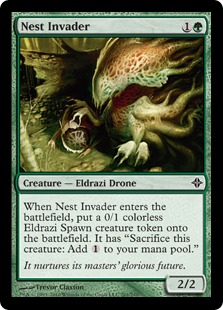
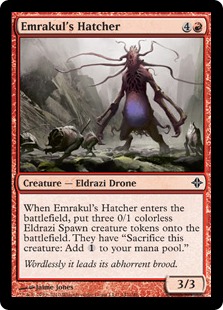
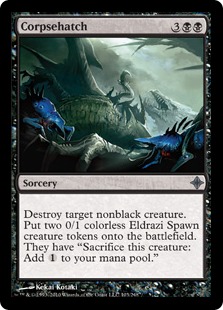
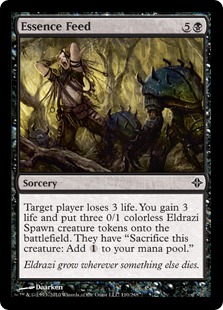
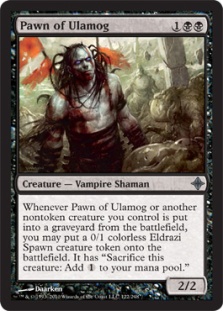
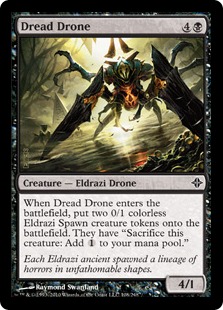
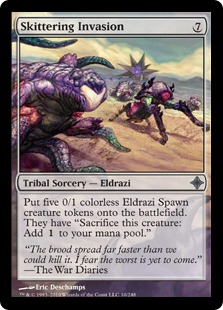
These cards fall into two categories. The first category is the spells that either are not reliable sources of Spawn or only provide Spawn in exchange for a lot of mana. Skittering Invasion costs seven mana, which even when it is discounted is one short of where you can begin to cast actual Eldrazi and the same price as All Is Dust! That’s pretty expensive, so such a deck is obviously aiming at least for Kozilek and probably wants to head straight for Emrakul. What a greedy, greedy bastard. Spells like Corpsehatch and Essence Feed don’t have a meaningful identity. If I am spending five or more mana on generating more mana, I don’t want to have to aim it at a creature and I don’t want to be aiming at my opponents’ head. One could look at it as generating a few free blocks along with the removal or a little bit of life gain, but these are gloriously inefficient options.
The creatures that bring Eldrazi Spawn along for the ride are better matches. Nest Invader puts down a cheap threat while giving you more mana to cast your next threat and not requiring you to strain your mana curve to the breaking point to take advantage of that mana, or if necessary the Spawn can shield from Consuming Vapors, Gatekeeper of Malakir or other Edict effects. Kozilek’s Predator and Emrakul’s Hatcher are harder to throw into a deck without a target for that mana. The net costs are excellent and in other cases the chump blockers will be appreciated, but passing up legitimate four- or five-drops is a powerful cost. There needs to be a plan for that extra mana in the coming turns and it has to be something that costs more than the enablers did. That is going to mean ramping up to spells that cost seven or more mana, and once you go to seven the real benefits don’t start until eight mana and either Terastodon or Eldrazi Conscription. At nine mana Iona enters the picture if you can make the colored mana work, and the true Eldrazi start at ten with Kozilek. Kozilek is a strange threat to go all-in on because its best feature is refueling your hand. Luckily, this is far from an All-In Red situation, and there will still be a good supply of lands available for rebuilding.
That leaves Awakening Zone. The ability to continuously generate Spawn can serve many different purposes. The Zone can generate a supply of chump blockers, food for an Eldrazi Monument, an extra mana every turn, save up for a huge spell, or do any combination of these strategies. No one of these effects is worthwhile on its own, especially on offense where this is painfully slow, but together in a defensive deck this is a powerful set of options. Green control decks don’t come around that often, and there isn’t currently much else to attract Standard control decks to Green, but this is far better suited to a splash than other Green mana sources, as it serves a purpose for the entire game. This was made to buy time while working towards Eldrazi or tap out control spells like Iona, Marshall Coup, or Mind Spring.
Last but not least there is Eldrazi Temple and the super-preview card Eye of Ugin. These are amazing at their main job, which is casting All is Dust and other giant spells. To run a package of these in a deck requires a commitment to go at least as far as Kozilek, which effectively shrinks to about eight and a half mana. That gives non-Blue decks a card drawer and gives Blue decks a finisher, so both are greatly helped in their quest to stick to one color, while playing control, or one color with a splash, which in turn allows them to run a colorless land package. If you’re going this route you won’t leave home without Everflowing Chalice, but this can look to replace Tectonic Edge on the theory that manlands are not as big an issue if you’re planning to go over the top of them.
There’s also the option to play Eldrazi Temple in a more aggressive build, probably combining it with either Eldrazi Spawn, a flood of mana creatures like those played by Mythic or both.
What do these mana sources mean for Standard players?
For those with most current decks, it means very little will change, but a few have some new good options.
Jund can’t use any of the new mana sources. The manlands from Worldwake fit right into Jund’s strategy but Rise of the Eldrazi is going in a different direction.
Mythic already has excellent mana and is structured on the plan of not trying to go larger than six mana spells. Any attempt to go larger would make the deck far less consistent without giving it that much more in the way of a power advantage, and the colored mana requirements of the deck are strong enough to banish any thoughts of an Eldrazi land package.
Naya has the same competition issues as Mythic and the same colored mana problems as well which should preclude any new mana additions. The high end doesn’t go high enough to justify Joraga Treespeaker over Birds of Paradise.
Vampires, WW, and Mono-Red strategies don’t have anything to consider.
Eldrazi Green gets help because it can best use Spawn as creatures. Joraga Treespeaker, Nest Invader, and Kozilek’s Predator are all good for that deck because they work well with Monument and help set up Overrun. The question is whether these are good enough to displace the current cards in the deck. My guess is that at least Nest Invader will make the cut, but I’m not sure about the others. If you’re playing Kozilek’s Predator that means you’re also playing Overrun. The competition is tough, both for slots and with other decks.
White/Blue Control is faced with a decision. It can go the Eldrazi Temple route and play new finishers or it can remain with more down to Earth finishers. The Chapin version doesn’t have any need for such a solution other than against other control decks. All is Dust is fine, but these builds don’t even play a full complement of Day of Judgment. All is Dust can handle Planeswalkers so having a few copies would be nice, but given how small an upgrade over Iona it would be to get Kozilek, the price in lands is too high. If the deck survives it will win, and if it does not survive it will already be dead. I am not a huge fan of Iona, but it only takes up two slots in the deck and that is not bad at all. The tap out control model is a lot more tempted by the Eldrazi, but the color requirements for Knight of the White Orchid and Mind Spring have already forced this deck to cut down on Tectonic Edge, so I doubt the colorless lands can be afforded.
What this does do to White/Blue Control is introduce a trump card. If you’re playing the Eldrazi and your opponent is not, you will not lose many games, especially if you’re packing the full Eye of Ugin package. As usual most players overestimate how strong their own deck is, so many control players will be tempted to make their decks otherwise worse, and this in turn will make other players scared of mirror matchups. By giving the deck additional options, the deck has likely been made worse rather than better.
These new mana sources want us to play decks that ramp into very expensive, very large men. Will these decks be able to compete? These efforts are swimming upstream at a steep angle, and my guess is that they will not succeed, but a noble attempt has been made.

